Ahaetulla nasuta
Ahaetulla nasuta, also known as common vine snake and long-nosed whip snake, is a slender green tree snake found in India, Sri Lanka, Bangladesh, Burma, Thailand, Cambodia and Vietnam.
| Green vine snake | |
|---|---|
 | |
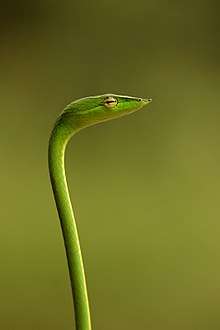 | |
| Scientific classification | |
| Kingdom: | Animalia |
| Phylum: | Chordata |
| Class: | Reptilia |
| Order: | Squamata |
| Suborder: | Serpentes |
| Family: | Colubridae |
| Genus: | Ahaetulla |
| Species: | A. nasuta |
| Binomial name | |
| Ahaetulla nasuta (Lacépède, 1789) | |
| Synonyms | |
|
Dryophis nasuta | |
It is not to be confused with Oxybelis fulgidus, "green vine snake" found in Central and South America. In Tamil, it is known as pachai paambu, In Marathi, it is known as shelati snake, In Malayalam it is known as pachila paambu,In Kannada it is known as Hasiru Haavu among dozens of other vernacular names.[1][2]
Description
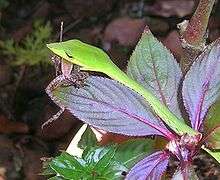
The green vine snake is diurnal and mildly venomous. This arboreal snake normally feeds on frogs and lizards using its binocular vision to hunt. They are slow moving, relying on camouflaging as a vine in foliage. The snake expands its body when disturbed to show a black and white scale marking. Also, they may open their mouth in threat display and point their head in the direction of the perceived threat. They are the only species of snake with horizontal pupils, compared to the normal vertical slit pupils found in many species of viper. [3]
The name Ahaetulla in Sinhala means 'eye plucker'. It earned this name, and similar ones in Tamil and Indian vernaculars, due to the mistaken belief that it strikes at the eyes.[4]
The species is viviparous, giving birth to young that grow within the body of the mother, enclosed within the egg membrane. They may be capable of delayed fertilization (parthenogenesis is rare but not unknown in snakes) as a female in the London zoo kept in isolation from August, 1885 gave birth in August, 1888.[5]
Taxonomic description
The following description with diagnostic characters is from Boulenger (1890):[6]
Snout pointed, terminating in a dermal appendage, which is shorter than the eye and formed entirely by the rostral; the length of the snout, without the appendage, about twice the diameter of the eye or rather more. No loreal; internasals and prefrontals in contact with the labials; frontal as long as its distance from the rostral or a little longer, as long as the parietals or a little longer; two preoculars and a small subocular (or one preocular and two suboculars), upper preocular in contact with the frontal; two postoculars; temporals 1+2 or 2+2; upper labials 8, fifth entering the eye; 4 lower labials in contact with the anterior chin-shields, which are shorter than the posterior. Scales in 15 rows. Ventrals 172-188; anal divided; subcaudals 140-166. Bright green or pale brownish, the interstitial skin between the scales black and white on the anterior part of the body, which appears striped when distended; a yellow line along each side of the lower surface. Total length 5 feet: tail 2.
Formerly treated as a subspecies Ahaetulla nasuta anomala is now regarded as a distinct species, Ahaetulla anomala.
Habitat
Found in low bushes, shrubs and trees in lowland forest terrain at elevations up to about 1000 metres, particularly near streams and often found near human settlements.[7]
Venom and its effects
The ingredients of the venom are unknown. The venom is moderately potent and can cause swelling, pain, bruising, numbness and other local symptoms, which will subside within three days. Bites close to the head, eyes and other vital areas could be severe. [8][9]
Vernacular names
- Sinhala: ඇහැටුල්ලා (Pronounced: Aheatulla)
- Telugu: పచ్చారి పాము.
- Bengali: লাউডগা.
- Odia: ଲାଉଡଙ୍କିଆ
- Kannada: ಹಸಿರು ಹಾವು, ಹಸಿರು ಬಳ್ಳಿ ಹಾವು.
- Gujarati: લીલવણ, માળણ.
- Marathi हरणटोळ, शेलाटी[10]
- Tamil: பச்சை பாம்பு
- Malayalam: പച്ചില പാമ്പ്,കൺകൊത്തി
Gallery
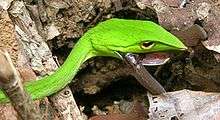 Eating a skink, Ristella travancorica
Eating a skink, Ristella travancorica- A nasuta in a threat display. Note the black and white interstices
 Green vine snake camouflaged in its habitat
Green vine snake camouflaged in its habitat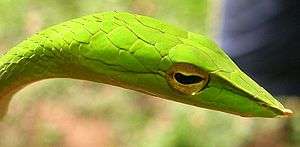 Head of Vine snake showing horizontal pupil
Head of Vine snake showing horizontal pupil Head
Head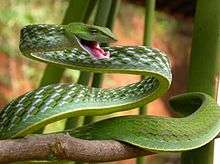 In threat posture
In threat posture Captive snake showing anger
Captive snake showing anger
Notes
- SNAKES by Dr. P. J. Deoras, Bombay.
- Chapter 4 Result and discussion - Shodhganga
- Brischoux, F.; Pizzatto, L.; Shine, R. (2010). "Insights into the adaptive significance of vertical pupil shape in snakes". Journal of Evolutionary Biology. 23 (9): 1878–1885. doi:10.1111/j.1420-9101.2010.02046.x. ISSN 1420-9101. PMID 20629855.
- Snakes of Sri Lanka Archived May 19, 2005, at the Wayback Machine
- Wall, Frank 1905. A popular treatise on the common Indian snakes. Part 1. J. Bombay Nat. Hist. Soc. 16:533-554.
- Boulenger, George A. 1890 The Fauna of British India, Including Ceylon and Burma. Reptilia and Batrachia. Taylor & Francis, London, xviii, 541 pp.
- http://www.toxinology.com/fusebox.cfm?fuseaction=main.snakes.display&id=SN0004
- Snakes of Sri Lanka Archived May 19, 2005, at the Wayback Machine
- “Ahaetulla nasuta” at WCH Clinical Toxinology Resources. Accessed on 9.1.2014 at http://www.toxinology.com/fusebox.cfm?fuseaction=main.snakes.display&id=SN0004
- AJANTA MINERALS DIST. GADCHIROLI (Maharashtra)
References
- Lacepède, B. G. E. 1789 Histoire Naturelle des Quadrupèdes Ovipares et de Serpens. Vol.2. lmprimerie du Roi, Hôtel de Thou, Paris, 671 pp.
- Wall, F. 1908 Remarks on some recently acquired snakes. J. Bombay N. H. S. xviii: 778-784
- Wall 1908 A new color variety of the common green whip-snake (Dryophis mycterizans). J. Bombay N. H. S. xviii: 919
- Wall, F. 1910 Remarks on the varieties and distribution of the common Green Whip Snake (Dryophis mycterizans). J. Bombay nat. Hist. Soc. 20: 229
- Wall 1910 Varieties of the common Green Whip Snake (Dryophis mycterizans). J. Bombay nat. Hist. Soc. 20: 524
| Wikimedia Commons has media related to Ahaetulla nasuta. |